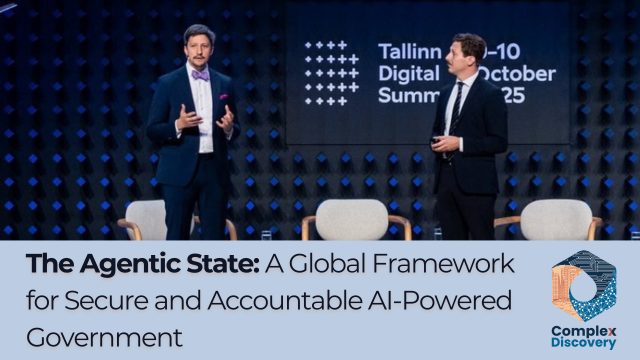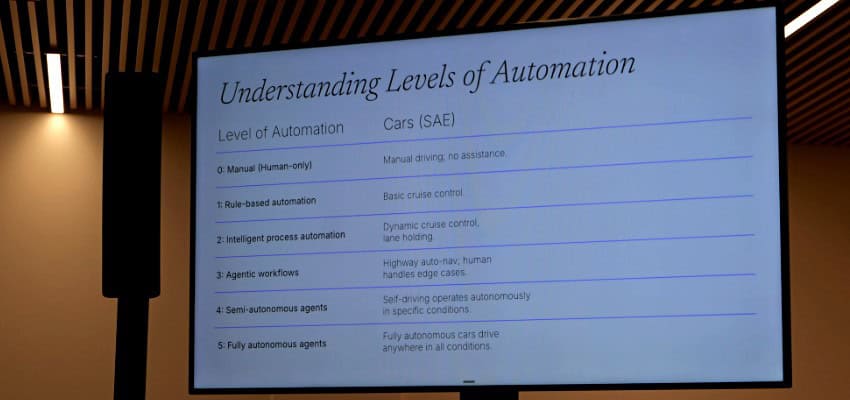
[EDRM Editor’s Note: This article was first published here on October 13, 2025, and EDRM is grateful to Rob Robinson, editor and managing director of Trusted Partner ComplexDiscovery, for permission to republish. All images in the article are courtesy of Rob Robinson.]
ComplexDiscovery Editor’s Note: Governments worldwide are on the brink of a transformation more radical than the digital revolutions of the past. In The Agentic State: Rethinking Government for the Era of Agentic AI, Luukas Ilves, Advisor to the First Deputy Prime Minister of Ukraine on AI and digital transformation and former Chief Information Officer of Estonia, and Manuel Kilian, Managing Director of the Global Government Technology Centre Berlin, along with over 20 global contributors, present the most comprehensive framework to date for embedding agentic artificial intelligence into the core functions of public administration. Released at the 2025 Tallinn Digital Summit, the paper introduces a twelve-layer model that redefines what it means to govern in the age of autonomous systems.
For cybersecurity, information governance, and eDiscovery professionals, the implications are immediate and far-reaching. From real-time compliance monitoring to agent-assembled legal dossiers and “compliance-as-code” enforcement, this blueprint positions AI not as a support tool but as an operational backbone. The challenges—from adversarial prompt injection to agent impersonation—demand a proactive security and governance strategy rooted in transparency, accountability, and digital trust. As governments begin implementing agentic pilot programs and building global standards, information professionals are uniquely positioned to lead in shaping how AI serves the public good—ethically, securely, and effectively.
“The Agentic State: Rethinking Government for the Era of Agentic AI” was released on October 9, 2025, presenting the most comprehensive framework to date for transforming public administration through autonomous artificial intelligence systems. The paper, developed with contributions from over 20 global digital government leaders, presents a comprehensive framework for how agentic AI will transform twelve core functions of government.
The vision paper, unveiled at the Tallinn Digital Summit by lead authors Luukas Ilves, former Chief Information Officer of Estonia, and Manuel Kilian, Managing Director of the Global Government Technology Centre Berlin, was followed by an expert workshop session exploring implementation strategies. The authors argue that agentic AI represents the most significant disruption to government operations since the rise of modern bureaucracy.
Unlike previous waves of digitization that simply automated existing processes, agentic AI systems can perceive complex situations, reason through problems, and take autonomous action within defined boundaries. The technology promises to shift government from reactive compliance-based operations to proactive, outcome-driven service delivery.
High-Profile International Collaboration
The distinguished contributors include Ukraine’s First Deputy Prime Minister, Mykhailo Fedorov; former U.S. Deputy Chief Technology Officer, Jennifer Pahlka; and Estonia’s Minister for Justice and Digital Affairs, Liisa Pakosta. Additional contributors span six continents, representing countries at various stages of digital transformation.
“The caliber of leaders who shaped this Vision Paper — from countries that have actually delivered digital transformation — signals a new chapter in international cooperation on government transformation,” said Kilian during the launch presentation.
Fedorov highlighted Ukraine’s pioneering role, noting that “Ukraine is already moving toward a model where just one request or a single voice message stands between a person’s need and the result. That is what an Agentic State looks like, where technology truly works for people.”

Twelve-Layer Transformation Framework
The paper outlines a comprehensive twelve-layer framework dividing agentic government into six implementation layers and six enablement layers. This structure recognizes that while agentic applications deliver immediate value, broader structural requirements must function effectively for successful deployment while preserving political accountability and public trust.
The implementation layers represent areas where agentic capabilities deliver immediate, visible value to citizens, businesses, and government operations. Public service design evolves from fragmented portals that require citizens to navigate departmental structures into proactive, personalized systems, where agents orchestrate complex needs across departments and anticipate issues before they arise. Government workflows evolve from rigid, predetermined processes into self-orchestrating systems that can coordinate tasks across agencies at machine speed, handling exceptions through reasoning rather than breaking down at edge cases.
Government workflows evolve from rigid, predetermined processes into self-orchestrating systems that can coordinate tasks across agencies at machine speed, handling exceptions through reasoning rather than breaking down at edge cases.
Rob Robinson, Editor and Managing Director, ComplexDiscovery.
Policy and rule-making shifts from episodic legislative cycles to continuous adaptation based on real-world evidence, with agentic systems simulating proposed regulations and adjusting statutes based on outcomes. Regulatory compliance transforms from periodic audits to real-time monitoring, with agents detecting violations as they occur and coordinating responses across multiple agencies instantaneously. Crisis response evolves from siloed command centers into integrated “nervous systems” where sensing, simulation, and first-response agents mobilize resources within seconds of detecting threats.
Public procurement becomes outcome-driven rather than process-focused, with autonomous agents negotiating contracts within policy constraints, enforcing supplier diversity requirements, and conducting continuous market analysis to optimize value while maintaining transparency through complete audit trails.
The enablement layers address structural foundations essential for agentic deployment. Agent governance frameworks establish accountability mechanisms, including cryptographic audit trails, structured explanations of agent decisions, and clear escalation paths to human oversight. Data and privacy architectures ensure information protection while enabling seamless interoperability through machine-readable formats and standardized APIs.
Technical infrastructure spans multimodal user interfaces enabling natural language interaction, LLM deployment and orchestration systems, agent-to-agent communication protocols, programmable digital public infrastructure for identity and payments, and elastic compute resources that scale dynamically with demand. Cybersecurity adopts an “ecosystem health” approach where continuous monitoring, quarantine protocols, and immunological responses protect against both adversarial attacks and system failures.
Public finance models adapt to variable, outcome-based costs with dynamic budget allocation and performance-based funding mechanisms. People, culture, and leadership transformation address the fundamental organizational shift required for effective human-AI collaboration, including workforce reskilling and new management approaches focused on outcome optimization rather than procedural compliance.

Critical Implications for Information Professionals
For cybersecurity professionals, the paper identifies novel threat vectors, including decision-process manipulation where adversaries inject malicious prompts to subvert agent reasoning, agent impersonation attacks, and cross-agent privilege escalation. The vision calls for “security as ecosystem health” with continuous behavioral monitoring, cryptographic agent identities, and quarantine protocols that isolate compromised systems while maintaining essential services.
The vision calls for “security as ecosystem health” with continuous behavioral monitoring, cryptographic agent identities, and quarantine protocols that isolate compromised systems while maintaining essential services.
Rob Robinson, Editor and Managing Director, ComplexDiscovery.
Information governance leaders will find particular relevance in the paper’s emphasis on data minimization, purpose limitation, and privacy-by-design architectures. The concept of “compliance-as-code” transforms regulations into executable logic that agents apply uniformly, ensuring policy fidelity while maintaining legal intent through version control and automated testing.
Legal discovery professionals can recognize parallels between traditional eDiscovery workflows and the paper’s envisioned agentic systems. Evidence-gathering agents could scour diverse data sources, apply adaptive filtering criteria, and assemble court-admissible dossiers with complete audit trails, dramatically accelerating litigation readiness and regulatory investigations.
Real-World Proof Points
The paper grounds its vision in existing deployments. Estonia’s e-Justice portal demonstrates automated document classification and intelligent routing that has significantly streamlined case processing. Ukraine’s Diia.AI digital agent provides proactive citizen outreach during crises faster than manual call centers. Financial institutions already deploy transaction monitoring systems processing millions of operations daily with minimal human intervention.
Global Action Platform Launch
Beyond the paper’s release, the initiative marks the beginning of a global action platform supported by the World Bank and Global Government Technology Centre Berlin. This platform aims to provide governments with practical frameworks, shared standards, and collaborative mechanisms for implementing agentic capabilities in a responsible manner.
“This paper is just the starting point for a longer term and continuous effort,” emphasized Ilves, who now serves as advisor to Ukraine’s First Deputy Prime Minister on digital transformation.
Urgent Call for Government Leadership
The authors stress that delay carries serious consequences. As private sector AI adoption accelerates, governments risk widening citizen frustration, enabling private intermediaries to fill service gaps, and ultimately implementing systems designed by others according to commercial rather than public priorities.
“The window for proactive choice is narrower than many government leaders recognize,” the paper warns, advocating for immediate experimentation and incremental adoption to develop the knowledge and capacity required for full transformation.
The window for proactive choice is narrower than many government leaders recognize.
“The Agentic State: Rethinking Government for the Era of Agentic AI,” Vision Paper by Luukas Ilves, Manuel Kilian, et al., October 2025.
During the workshop session that followed the presentation, experts explored practical implementation challenges and discussed how governments can begin pilot programs while building the necessary governance frameworks. The collaborative discussion emphasized the importance of starting with limited scope deployments and scaling based on evidence and citizen feedback.
The complete vision paper is available at www.agenticstate.org, marking the beginning of what authors hope will become a global movement toward governments that are not just digital, but truly agentic in serving the public good.
Read the original article here.

About ComplexDiscovery OÜ
ComplexDiscovery OÜ is a highly recognized digital publication providing insights into cybersecurity, information governance, and eDiscovery. Based in Estonia, ComplexDiscovery OÜ delivers nuanced analyses of global trends, technology advancements, and the legal technology sector, connecting intricate issues with the broader narrative of international business and current events. Learn more at ComplexDiscovery.com.
News Sources
- “The Agentic State: Rethinking Government for the Era of Agentic AI,” Vision Paper by Luukas Ilves, Manuel Kilian, et al., October 2025. Available at agenticstate.org.
- Agentic AI Workshop Transcript, Tallinn Digital Summit 2025, October 9, 2025. Expert discussion session following the vision paper presentation.
- Tallinn Digital Summit 2025
Additional Reading
- Cyberocracy and the Efficiency Paradox: Why Democratic Design is the Smartest AI Strategy for Government
- The European Union’s Strategic AI Shift: Fostering Sovereignty and Innovation
- Learning from Collective Failures: A Pre-Summit Reflection on AI Governance
- When the Sky Falls Silent: Europe’s New Hybrid Threat Landscape
- European Drone Incidents Expose Critical Gaps in Enterprise Security and Hybrid Defense
Source: ComplexDiscovery OÜ
Assisted by GAI and LLM Technologies per EDRM GAI and LLM Policy.

